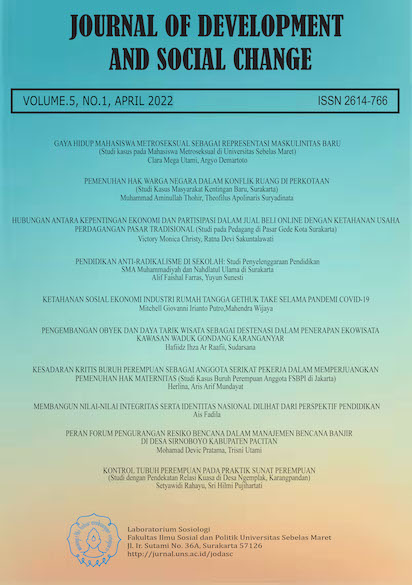MINAT PEMUDA PADA PERTANIAN HORTIKULTURA DI DESA KELOR KECAMATAN KARANGMOJO KABUPATEN GUNUNGKIDUL
Abstract
Youth is a valuable asset to the country. The success of the nation's development depends on the level of its youth participation. Phenomena declining the interest of youth in agriculture is a special concern for society and government. Amid in the youth interest in the agricultural sector work, there is a group of farmers who have an interest in agriculture, especially horticultural. The purpose of this research is to see the process of increasing youth interest in horticultural farming, a factor that affects youth interest and the process of forming rational youth choices related to increased interest in horticultural farming. Qualitative research with a descriptive exploratory approach was conducted in the village Kelor Karangmojo District in Gunungkidul Regency. Sampling techniques using purposive sampling techniques. As for the research, informant consists of the youths who belong in a group of horticultural farmer Youth, non-village youth groups and village devices. Data is collected by observing, post conducting interviews and documentation. To test the data validity using source triangulation. Data analysis techniques use interactive models of Miles and Huberman with the rational choice theory of James S. Coleman.
The results showed the process of increasing youth interest through: increased youth involvement in horticultural farms that are differentiated into direct involvement and supporting involvement about concerning frequency, long farmed and The youth-owned land area; Increased members of Horticulture Farmer Youth Group; Raising horticultural farmland; and increased youth innovations in horticultural farming. In the factors that affect the interest of the driving factor is the inner urge, social motivation, and emotional factor also the traction factor in the form of economic factors and market availability. The rational choice of youth against horticultural farming occurs because of the objectives that youths want to achieve by doing horticultural farming activities. Youth access to natural resources as well as capital is a tool for youth to get their goals. In maximizing the efforts of youth conduct collective behavior that is by forming a group of agriculture that has access to human resources and capital resources that can overcome the limitations of youth actors of individuals in activities Horticultural farming.
Full Text:
PDFReferences
Ahmadi dan Irsal. 2006. Inovasi teknologi pengembangan pertanian lahan rawa lebak. Prosiding Seminar Nasional “Pengembangan Pertanian”. Banjarbaru: Balai Penelitian Pertanian Lahan Rawa.
Apriyanto A. (2012). Pembangunan Pertanian di Indonesia. Dipetik Desember, 30, 2019. Dari http://www.deptan.go.id/renbangtan/konsep_pembangunan_pertanian.pdf.
Direktorat Jendral Hortikultura. Rencana Strategis Direktorat Jendral Hortikultura 2015-2019. Dipetik Juli, 29, 2019. Dari http://hortikultura.pertanian.go.id/wp-content/uploads/2015/06/Bab-II.pdf
Djaali. (2008). Psikologi Pendidikan. Jakarta: Bumi Aksara.
Hadi, P.U., Mayrowani, H. Supriyati dan Sumedi. 2000. Review and Outlook Pengembangan Komoditas Hortikultura. Seminar Nasional Perspektif Pembangunan Pertanian dan Kehutanan Tahun 2001 ke Depan. Pusat Penelitian Sosial Ekonomi Pertanian. Bogor: Badan Penelitian dan Pengembangan Pertanian.
Istiqomah, Kurnia. (2017). Hubungan Persepsi dengan Sikap Pemuda Pedesaan Mengenai Pekerjaan Pertanian Hortikultura (Desa Ciputri Kecamatan Pacet Kabupaten Cianjur Jawa Barat). Skripsi Institut Pertanian Bogor. Dipetik April, 11 ,2019. Dari https://repository.ipb.ac.id/jspui/handle/123456789/93/browse?type=title&sort_by=1&order=ASC&rpp=60&etal=5&null=&offset=459
Kementrian Pertanian. Peraturan Menteri Pertanian Nomor 82/Permentan/OT.140/8/2013. Dipetik Juli, 30, 2019. Dari http://perundangan.pertanian.go.id/admin/p_mentan/Permentan%20No.82%20T ahun%202013.pdf
Mardikanto, Totok. (2007). Penyuluhan Pembangunan Pertanian. Surakarta: UNS Press.
Mukhlis, 2007. Analisis Tanah Dan Tanaman. Medan: USU Press.
Musyafak ahmad dan Tatang M.Ibrahim, 2005. Strategi Percepatan Adopsi dan Difusi Teknologi Pertanian dalam Prima Tani. Journal Analisis kebijakan Pertanian, Vol.1.No.1, Maret 2005.
Nugraha YA. (2012). Hubungan orangtua, media massa, dan teman dengan sikap pemuda terhadap pekerjaan di bidang pertanian (kasus pemuda di Cipendawa dan Sukatani, Kecamatan Pacet Kabupaten Cianjur). Bogor: Institut Pertanian Bogor.
Prastowo B. (2007). Potensi Sektor Pertanian Sebagai Penghasil dan Pengguna Energi Terbarukan. Jurnal Perspektif Vol. 6 No. 2. Dipetik Januari, 10, 2019. Dari http://ejurnal.litbang.pertanian.go.id/index.php/psp/article/view/2862/2489.
Suhartini, Yati. (2011). Analisis Faktor-Faktor Yang Mempengaruhi Minat Mahasiswa dalam Berwiraswasta. Jurnal Akmenika UPY, Vol. 7.
Untari et al. (2007). Implementasi Prinsip-Prinsip Pertanian Berkelanjutan oleh Petani di Kabupaten Kulon Progo. Ilmu-ilmu Pertanian 3(2): 144-155. Dipetik Maret, 2, 2019 dari http://stppyogyakarta.com.
White B. (2011). Who will own the countryside dispossession, rural youth and the future of farming. International Institute of Social Studies. Dipetik Maret, 18, 2019 dari http://pustaka.setjen.pertanian.go.id/.
(2012). Agriculture and the Generation Problem: Rural Youth, Employment and the Future of Farming. Journal IDS Bulletin Volume 43 Number 6. Dipetik Januari, 10, 2019 dari https://core.ac.uk/download/pdf/43538583.pdf
Wiradi, Gunawan. (2009). Metodologi Studi Agraria. Bogor: Sajogyo Institute.
DOI: https://doi.org/10.20961/jodasc.v2i1.41657
Refbacks
- There are currently no refbacks.




